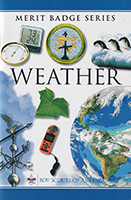
Fig. 1: Weathe-J2-Front
- Embroidery: Rayon thread
- Border: Merrowed

Fig. 2: Weathe-J2-Reverse
- Back: Smooth clear NO Scout Stuff imprint Bisphenol A (BPA) free plastic
Item Name: Weather 2009 - 2010
Item ID: Weathe-J2
Collector Rating: 1
Requirements January 2007 until January 2014
1. Define meteorology. Explain what weather is and what climate change is. Discuss how the weather affects farmers, sailors, aviators, and the outdoor construction industry. Tell why weather forecasts are important to each of these groups.
2. safety rules with your family.
3. Explain the difference between high and low pressure systems in the atmosphere. Tell which in related to good and to poor weather. Draw cross sections of a cold front and a warm front, showing the location and movements of the cold and warm air, the frontal slope, the location and types of clouds associated with each type of front, and the location of precipitation.
4. Tell what causes wind, why it rains, and how lightning and hail are formed.
5. Identify and describe clouds in the low, middle, and upper levels of the atmosphere. Relate these to specific types of weather.
6. Draw a diagram of the water cycle and label its major processes. Explain the water cycle to your counselor.
7. Define acid rain. Identify which human activities pollute the atmosphere as well as the effects such pollution can have on people.
8. Do ONE of the following:
(a) Make of the following instruments: wind vane, anemometer, rain gauge, hygrometer. Keep a daily weather log for one week using information from this instrument as well as from other sources such as local radio and television stations, NOAA Weather Radio, and Internet sources (with your parent’s permission). Record the following information at the same time every day: wind direction and speed, temperature, precipitation, and types of clouds. Be sure to make a note of any morning dew or frost. In the log, also list the weather forecasts from radio or television at the same time each day and show how the weather really turned out.
(b) Visit a National Weather Service office or talk with a radio or television weathercaster, private meteorologist, local agricultural Extension service office, or university meteorology instructor. Find out what type of weather is most dangerous or damaging to your community. Determine how severe weather and flood warnings reach the homes in your community.
9. Do ONE of the following:
(a) Give a talk of of at least five minutes to a group (such as your unit or a Cub Scout pack) explaining the outdoor safety rules in the event of lighting, flash floods, and tornadoes. Before your talk, share your outline with your counselor for approval.
(b) Read several articles about acid rain and give a prepared talk of at least five minutes to a group (such as your unit or a Cub Pack) about the articles. Before your talk, share your outline to your counselor for approval.
10. Find out about a weather-related career opportunity that interest you. Discuss with and explain to your counselor what training and education are required for such a position, and the responsibilities required of such a position.

